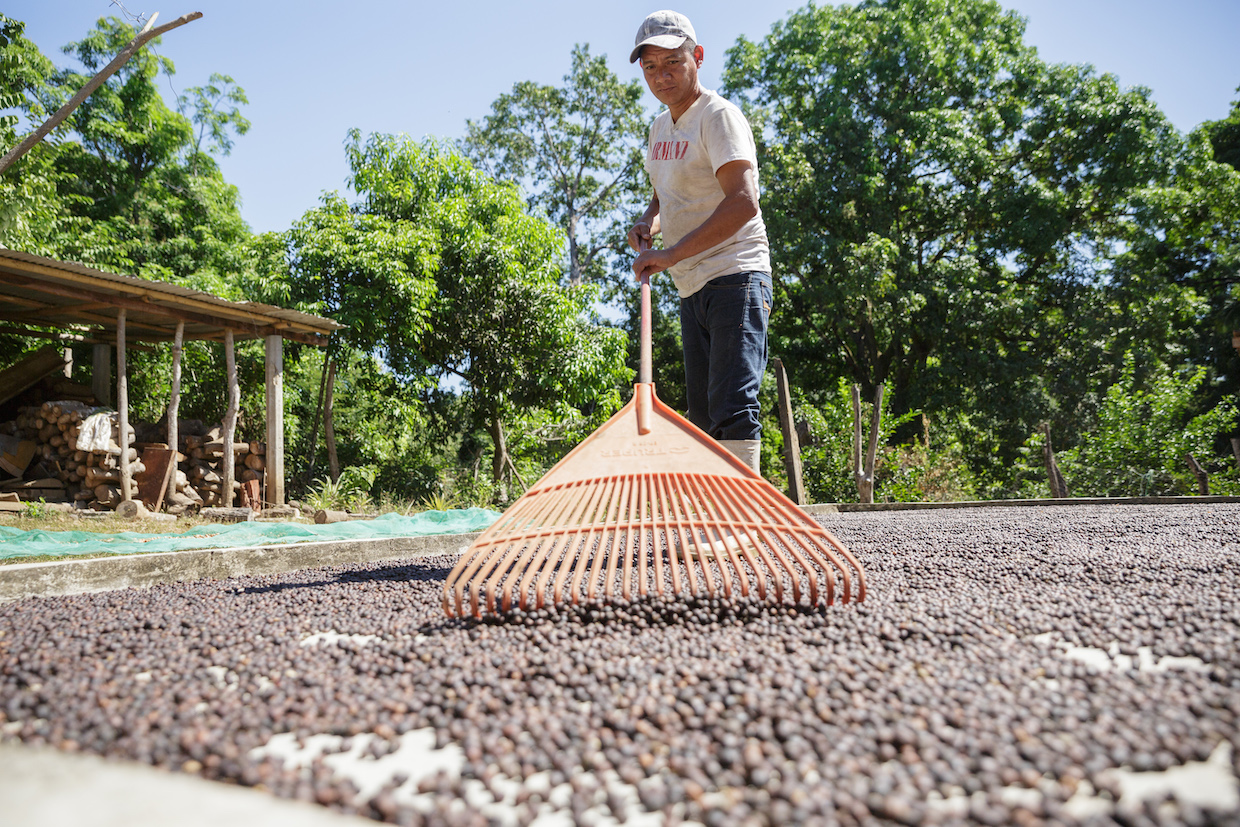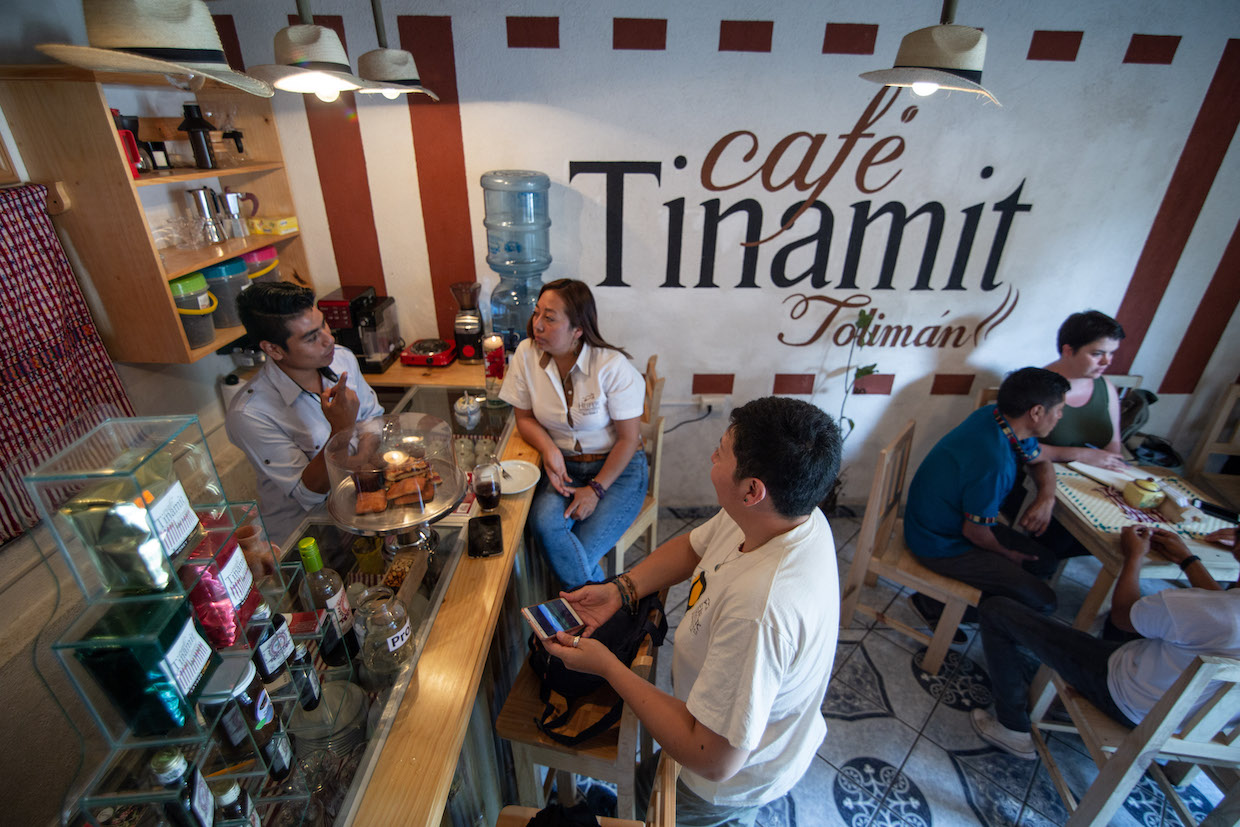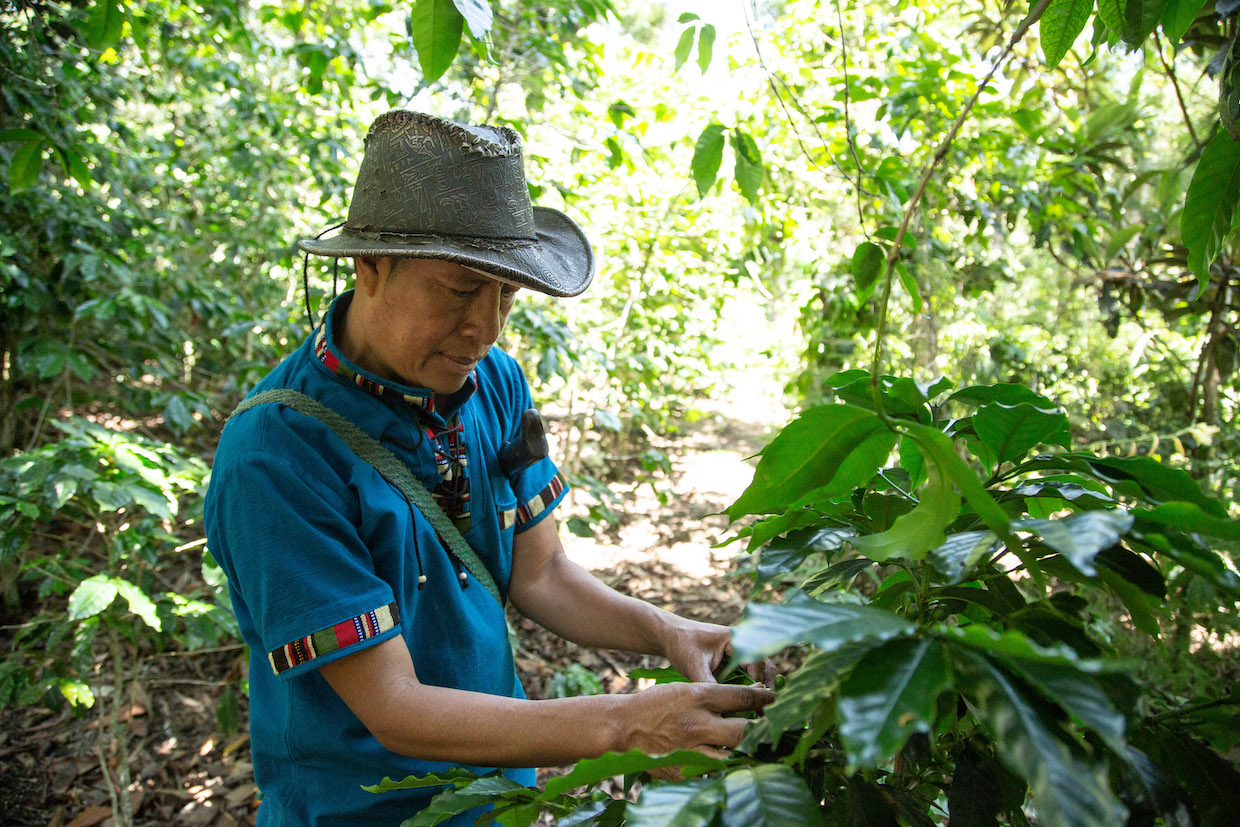
Guatemala. (Left to right) Heifer Enterprise Facilitator Patricia Tax, Esdras and production specialist Edgar examine a small coffee plant. Photo: Phillip Davis/Heifer International
As we wade deeper into the information age — in which knowledge is power and data its most sought-after currency — transparency has taken on new importance.
Information is not neutral; it is a conduit for capacity, wealth, and privilege. As such, it should be harnessed with weighty responsibility.
This is precisely why transparency has become such a heavily debated topic, and why some people are so excited about the prospect of technologies designed to democratize data, such as blockchain.
Information in the Coffee Sector
Fortunately, frank conversations about data and information ownership are finally happening in coffee. As an industry, we’re realizing information-seeking practices are often extractive, if not downright exploitative.
Data capturing and usage in coffee often does not facilitate two-way information flows, nor foster reciprocal empowerment; and it certainly has not helped to adequately compensate producers for the value of their contributions.

Mexico. Rudy Lopez Carrillo, 38, spreads part of his family’s coffee harvest to dry in the sun behind their home. Photo: Olivier Asselin/Heifer International.
If coffee’s many power imbalances, including value distribution and bargaining capacity, are to be rectified, the solution needs to start with information — how it’s used, and, crucially, who has access to it and why.
The State of the Smallholder Coffee Farmer
Connecting these dots is exactly what brought Heifer International together with Lutheran World Relief, the Agroecology and Livelihoods Collaborative (ALC) at the University of Vermont and Statistics for Sustainable Development (Stats4SD) to develop a new open-access platform called the State of the Smallholder Coffee Farmer.
This initiative seeks to build a comprehensive understanding of smallholder coffee farmers’ realities, centering on the intersection of economic, social and environmental dimensions. The intent has been to provide a counterbalance to existing research, which has tended to focus downstream, assessing coffee in terms of productive output and traded value.

Guatemala. Large coffee plantations like this supply major coffee companies around the world. Photo: Phillip Davis/Heifer International
By zooming into the household and community levels, the work recognizes coffee as a livelihood and ecosystem lynchpin, drawing a more holistic picture of the role it plays locally. Additionally, State of the Smallholder Coffee Farmer promotes producer access and autonomy over their own data, removing barriers to equitable information-sharing among different actors in the coffee supply nexus.
The need for such an initiative has been longstanding but grew increasingly more urgent in 2019, as the price crisis in the coffee lands made headlines. Years of sustained C-market depression had taken a mounting toll, compounding poverty among coffee growers.
The ripple effect exacerbated human rights violations in prominent supply chains, spurred an influx of emigration from Central America and drove deforestation. A wave of natural disasters in key coffee-producing countries and the COVID-19 pandemic rubbed salt in the gaping wound of systemic inequity and injustice.
Unexplored Questions
As part of a multi-year relationship designed to combat unjust coffee systems, Heifer International and Lutheran World Relief sought to mobilize a response to these acute challenges.
As we looked to identify means for both immediate organizational assistance and for broader resiliency support, some significant questions bubbled to the surface.
Just how much of this economic refugee activity in the Northern Triangle was tied to coffee livelihoods? In what quantifiable ways does smallholder production protect ecosystems or mitigate the effects of climate change; and what are the environmental outcomes if coffee lands are converted? Exactly how closely are market prices and household incomes tied to one another?

Guatemala. Customers and staff enjoy themselves at Café Tinamit. Photo: Phillip Davis/Heifer International
Despite the volume of papers, reports, platforms and multi-stakeholder partnerships surrounding coffee, the lack of research addressing these high-level queries has been remarkable although not surprising considering funding for such endeavors typically comes from wealthier actors in the supply stream.
An abundance of data exists to support buyers’ decision making, yet there’s little ability to provide crucial insight where it’s needed most, among the most vulnerable upstream actors.
Developing an Inclusive Tool
Thus, our work became less about answering our initial questions and plugging holes, and more about developing a tool that producers and their organizations could use to answer their own questions, make their own analyses, plug their own holes, draw their own conclusions and make their own informed decisions. A goal is to level the playing field with other value chain actors, who have held the information advantage for years.
Ultimately, two years of multi-stakeholder work has culminated in a pilot version of State of the Smallholder Coffee Farmer platform, which encompasses extensive review, analysis, and synthesis of existing data.

Guatemala. Production specialist Edgar looks at some green coffee beans grown by the Tinamit Coffee Cooperative. Photo: Phillip Davis/Heifer International
The current version includes more than 200 indicators, with 630 indicator values, organized into five main categories on coffee smallholders in Guatemala, Honduras and Nicaragua. It includes key takeaways from 23 interviews and incorporates raw information from a multitude of ‘data donors.’
Available in Spanish and English, the platform currently hosts two core functionalities: One is to provide an open-access report detailing the approach, findings, organizational interviews and discussions. It serves as a deep dive into both the state of the smallholder coffee farmer in these three countries, as well as detailing the state of research on smallholder coffee farming.
The other is an interactive indicator hub where users can ‘choose their own adventure’ in terms of selecting categories and sub-categories, then filtering by country, year, source type, source purpose, gender disaggregation and scope.

Nicaragua 2019.
A scenic shot of the countryside from the top of a hill. Photo: Phillip Davis/Heifer International
These values can be previewed individually or downloaded to create a spreadsheet and/or graph. While the 2022 State of the Coffee Smallholder Farmer pilot is the first step in creating a more democratic and producer-centric information landscape, the goal is expansion into a larger, more permanent effort that includes more countries and broader industry support.
Visit coffeesmallholder.org to play with the platform, dig into the research and get in touch with the team.
[Note: Any views or opinions expressed in this piece are those of the author and are not necessarily shared by Daily Coffee News or its management. Do you have a story idea for DCN? Share it here.]
Cory Gilman
Cory Gilman is never happier than when working to build equitable, inclusive and regenerative coffee systems — with a passion for prosperous farmer livelihoods as a precursor for broader environmental and social outcomes. Prior to focusing specifically on coffee, she spent a decade advancing sustainability initiatives for leading CPG companies. After a year living with and learning from smallholder farmers across Southeast Asia, Cory knew she wanted to spend her career supporting the people behind every cup and the places they call home. "She holds a Masters degree in Sustainable Development and Social Innovation, and is eager to support more resilient and equitable supply chains across sectors.






Comment